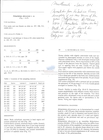WoRMS taxon details
Molgolaimus abyssorum Muthumbi & Vincx, 1996
221185 (urn:lsid:marinespecies.org:taxname:221185)
accepted
Species
marine
Muthumbi, A. W.; Vincx, M. (1996). Nematodes from the Indian Ocean: description of six new species of the genus Molgolaimus Ditlevsen, 1921 (Nematoda: Desmodoridae). <em>Bulletin de l'institut Royal dae Sciences Naturelles de Belgique. Biologie.</em> 66: 17 - 28. (look up in IMIS) [details] Available for editors  [request]
[request]
Description Characterised by a small body, faint circular striations; amphids circular, small and located close to the anterior end;...
Description Characterised by a small body, faint circular striations; amphids circular, small and located close to the anterior end; spicules short and slightlycurved on the proximal end and no pre-cloacal supplements. [details]
Nemys eds. (2025). Nemys: World Database of Nematodes. Molgolaimus abyssorum Muthumbi & Vincx, 1996. Accessed through: World Register of Marine Species at: https://www.marinespecies.org/aphia.php?p=taxdetails&id=221185 on 2025-04-17
Date
action
by
![]() The webpage text is licensed under a Creative Commons
Attribution 4.0 License
The webpage text is licensed under a Creative Commons
Attribution 4.0 License
Nomenclature
original description
Muthumbi, A. W.; Vincx, M. (1996). Nematodes from the Indian Ocean: description of six new species of the genus Molgolaimus Ditlevsen, 1921 (Nematoda: Desmodoridae). <em>Bulletin de l'institut Royal dae Sciences Naturelles de Belgique. Biologie.</em> 66: 17 - 28. (look up in IMIS) [details] Available for editors  [request]
[request]
Other
context source (Deepsea)
Miljutin, D. M.; Gad, G.; Miljutina, M. M.; Mokievsky, V. O.; Fonseca-Genevois, V.; Esteves, A. M. (2010). The state of knowledge on deep-sea nematode taxonomy: how many valid species are known down there?. <em>Marine Biodiversity.</em> 40(3): 143-159., available online at https://doi.org/10.1007/s12526-010-0041-4 [details] Available for editors  [request]
[request]
additional source Fonseca, G.; Vanreusel, A.; Decraemer, W. (2006). Taxonomy and biogeography of Molgolaimus Ditlevsen, 1921 (Nematoda: Chromadoria) with reference to the origins of deep sea nematodes. <em>Antarctic Science.</em> 18(01): 23-50., available online at https://doi.org/10.1017/s0954102006000034 [details] Available for editors [request]
[request]
additional source Vermeeren, H. (2002). Biogeografie van Antarctische diepzeenematoden: species turn-over in dominante genera van de familie Chromadoridae. <em>Licentiaatsthesis UGent Faculteit Wetenschappen Academiejaar 2001-2002.</em> [details] Available for editors [request]
[request]
additional source Leduc, D.; Fu, S.; Zhao, Z. Q. (2019). New nematode species from the continental slope of New Zealand (Chromadorea, Microlaimida, and Chromadorida), and unexpected placement of the genus Molgolaimus Ditlevsen, 1921. <em>Marine Biodiversity.</em> 49(5): 2267-2280., available online at https://doi.org/10.1007/s12526-019-00961-z [details] Available for editors [request]
[request]
additional source Fonseca, G.; Vanreusel, A.; Decraemer, W. (2006). Taxonomy and biogeography of Molgolaimus Ditlevsen, 1921 (Nematoda: Chromadoria) with reference to the origins of deep sea nematodes. <em>Antarctic Science.</em> 18(01): 23-50., available online at https://doi.org/10.1017/s0954102006000034 [details] Available for editors
additional source Vermeeren, H. (2002). Biogeografie van Antarctische diepzeenematoden: species turn-over in dominante genera van de familie Chromadoridae. <em>Licentiaatsthesis UGent Faculteit Wetenschappen Academiejaar 2001-2002.</em> [details] Available for editors
additional source Leduc, D.; Fu, S.; Zhao, Z. Q. (2019). New nematode species from the continental slope of New Zealand (Chromadorea, Microlaimida, and Chromadorida), and unexpected placement of the genus Molgolaimus Ditlevsen, 1921. <em>Marine Biodiversity.</em> 49(5): 2267-2280., available online at https://doi.org/10.1007/s12526-019-00961-z [details] Available for editors
 Present
Present  Present in aphia/obis/gbif/idigbio
Present in aphia/obis/gbif/idigbio  Inaccurate
Inaccurate  Introduced: alien
Introduced: alien  Containing type locality
Containing type locality
Unreviewed
Description Characterised by a small body, faint circular striations; amphids circular, small and located close to the anterior end; spicules short and slightlycurved on the proximal end and no pre-cloacal supplements. [details]


